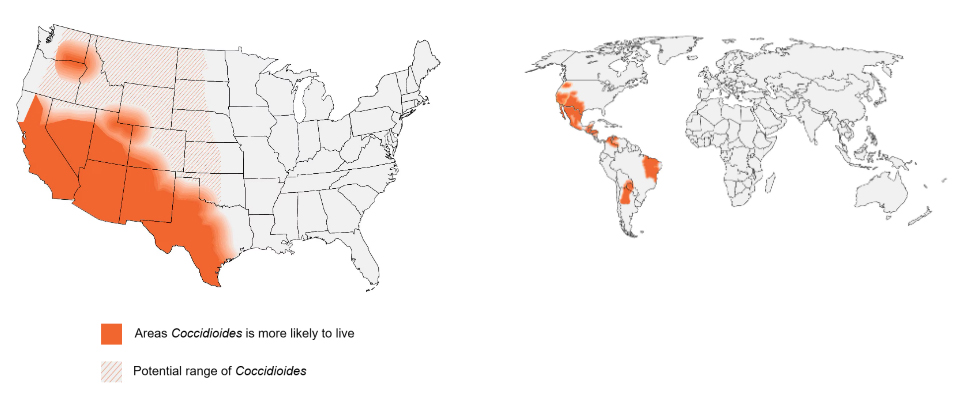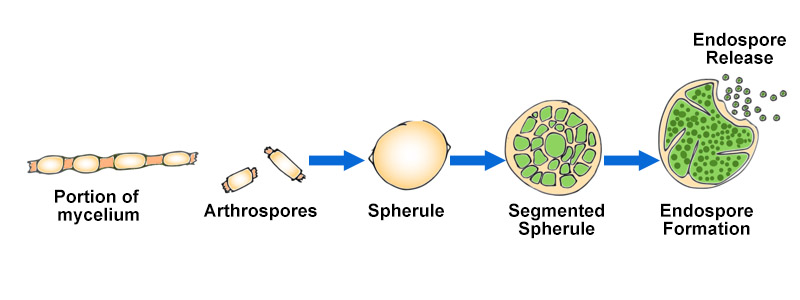Cocci is a fungus present in certain areas of the Western Hemisphere. You can get infected with Cocci if you live or travel to these areas. Read on to learn more about this infection or the fungus that causes it.

WHAT IS IT?
Overview
Coccidioidomycosis, (pronounced kok-SID-ee-oy-doh-my-KOH-sis), commonly called Valley Fever or Cocci, is a fungal disease caused by the Coccidioides (pronounced kok-SID-ee-oy-deez) fungus. The Cocci fungus is endemic in the Southwest United States and the arid areas of Eastern Washington State, as shown in Figure 1. Outside of the United States, this fungus is present in parts of Mexico and South and Central America. The areas where Cocci can be found seem to be expanding, potentially due to changes in rainfall and temperature associated with climate change. Periods of drought can also increase the number of Cocci infections in the endemic region.
Figure 1. Areas where Coccidioides fungi can be found. Reproduced with permission from CDC and MSGERC.

Cocci is a growing problem. In 2019, there were 20,003 confirmed cases of Valley Fever reported in the United States. Most cases are diagnosed in people living in or visiting Arizona or California. The number of cases is believed to be drastically underestimated because many people affected by the disease aren’t diagnosed. Most people who experience Cocci will recover, but unlike symptoms associated with more common respiratory illnesses, the symptoms associated with Cocci may last six months or longer. On average, approximately 200 deaths a year are attributed to Cocci in the United States. This is also likely underreported. The economic impact of the disease is estimated to be more than 1.5 billion US dollars. For these reasons, improving awareness, diagnosis, and the management of Cocci will have a large public health impact.
What’s in a Name?
You may hear Cocci referred to in several ways. For simplicity, on first mention we will use the technical term, then through the rest of the document we will use the short term, Cocci. Here are some of the other terms you may encounter that describe the disease or the fungus, along with a brief explanation of how those terms arose:
- “Valley Fever”—this is the term typically used to describe the fungal lung infection caused by Cocci. Sometimes it’s used to describe other forms of the disease. It gets its name because the first cases described in the United States occurred in in the San Joaquin Valley of California
- “San Joaquin Valley Fever”—another term that shows a geographical association
- “Desert rheumatism”—this name came about because Cocci is often present in the desert region. Rheumatism is added to “desert” because people can develop painful joints from the fungus because of their body’s reaction to the fungus (inflammation)
- “Cocci”—this term is just a lot shorter and easier to say than Coccidioides or coccidioidomycosis
- “Disseminated cocci” or “Disseminated Valley Fever”—this term means that the disease has spread from the primary location (usually the lung) to other parts of the body
- “Cocci Meningitis,” “Valley Fever Meningitis,” or “CNS Cocci” – these terms refer to disease that has invaded the brain or central nervous system
How Do You Get Infected?
From airborne spores
Coccidioides fungi live in the soil in what is called the mycelial phase (see SCIENCE SIDEBAR for detail) in environments that are dry (arid or semiarid). As shown in Figure 2, when the soil is disturbed—by human activities like excavation, animal activities, or weather events like earthquakes or fires—fungal arthrospores (we’ll call them spores for simplicity) are released into the air. These spores are not visible to the naked eye, and once in the air can travel 75 miles or more from where they became airborne. People (and animals) can inhale these spores. Once inside the body, the fungus changes to a different form and grows into spherules, which eventually release new fungal cells (endospores) and the process continues. This is the lifecycle of the fungus and the typical method of disease transmission.
Figure 2. Lifecycle of Cocci, showing the phases in the soil and in the mammalian host. Reproduced with permission from the CDPH Valley Fever Fact Sheet.

Through your skin
Less commonly, fungal spores can enter your skin through a cut, wound, or splinter and cause a skin infection. This is known as an implantation mycoses. This method of transmission is rare but has been documented in fieldworkers or people with traumatic injuries.
Frequently Asked Questions
Cocci is not spread from person to person.. The normal route of infection is from inhalation; however, there have been some rare cases where infection was caused by:
- A wound infected with Cocci releases spores in the air, which people inhale
- Organ transplant from an infected donor
- Contact with a contaminated item, such as an article of clothing
- Exposure of laboratory personnel to Cocci while processing a specimen
Pregnant women don’t seem to be able to transmit the Cocci infection to their babies.
Figure 3: Forms of Cocci during the different lifecycle stages. Modified from image provided by Saurabh Patil, via Wikimedia Commons.


